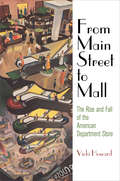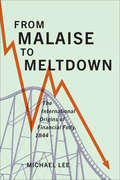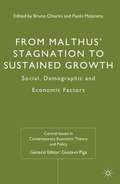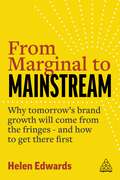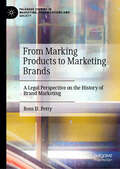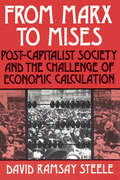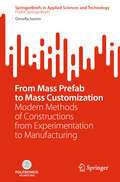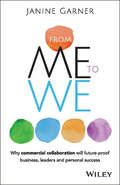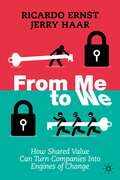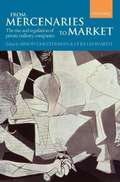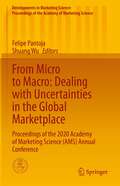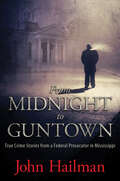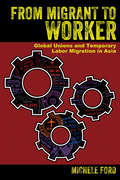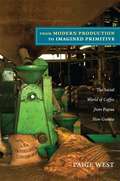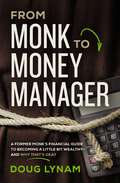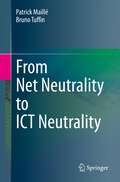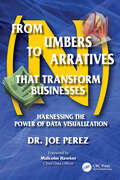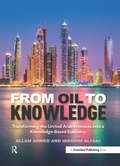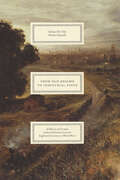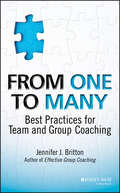- Table View
- List View
From Main Street to Mall
by Vicki HowardThe geography of American retail has changed dramatically since the first luxurious department stores sprang up in nineteenth-century cities. Introducing light, color, and music to dry-goods emporia, these "palaces of consumption" transformed mere trade into occasions for pleasure and spectacle. Through the early twentieth century, department stores remained centers of social activity in local communities. But after World War II, suburban growth and the ubiquity of automobiles shifted the seat of economic prosperity to malls and shopping centers. The subsequent rise of discount big-box stores and electronic shopping accelerated the pace at which local department stores were shuttered or absorbed by national chains. But as the outpouring of nostalgia for lost downtown stores and historic shopping districts would indicate, these vibrant social institutions were intimately connected to American political, cultural, and economic identities.The first national study of the department store industry, From Main Street to Mall traces the changing economic and political contexts that transformed the American shopping experience in the twentieth century. With careful attention to small-town stores as well as glamorous landmarks such as Marshall Field's in Chicago and Wanamaker's in Philadelphia, historian Vicki Howard offers a comprehensive account of the uneven trajectory that brought about the loss of locally identified department store firms and the rise of national chains like Macy's and J. C. Penney. She draws on a wealth of primary source evidence to demonstrate how the decisions of consumers, government policy makers, and department store industry leaders culminated in today's Wal-Mart world. Richly illustrated with archival photographs of the nation's beloved downtown business centers, From Main Street to Mall shows that department stores were more than just places to shop.
From Malaise to Meltdown: The International Origins of Financial Folly, 1844–
by Michael LeeFor the past two centuries, the great power sitting atop the international global financial system has enjoyed outsized rewards. As the saying goes, however, all good things come to an end. Providing insights into the evolution of the global political economy, From Malaise to Meltdown identifies the main instigators behind the global financial crises we’ve seen in the last two hundred years. Michael Lee shows that, in time, power diffuses from the leading economy to others, creating an intensely competitive push for global financial leadership. Hungry for the benefits of global leadership, declining leaders and aspiring challengers alike roll back long-standing regulatory safeguards in an effort to spark growth. Risks to global financial stability mount as a result of this rollback and waves of severe financial crises soon follow. As Lee deftly shows, the Long Depression of 1873–1896, the Great Depression of 1929–1939, and the financial crisis of 2008 are part of the same recurrent pattern: global competition disrupts the longstanding political equilibria, prompting a search for new, risky ideas among the most powerful states. From Malaise to Meltdown presents a sweeping but accessible historical narrative about the coevolution of power, ideas, and domestic politics, supported by archival research into the risky decisions that ushered in the worst financial crises in history.
From Malthus’ Stagnation to Sustained Growth
by Paolo Malanima Bruno ChiariniA detailed exploration of the influence and utility of Thomas Malthus' model of population growth and economic changes in Europe since the nineteenth century. This important contribution to current discussions on theories of economic growth includes discussion of issues ranging from mortality and fertility to natural resources and the poverty trap.
From Marginal to Mainstream: Why Tomorrow’s Brand Growth Will Come from the Fringes - and How to Get There First
by Helen EdwardsLegacy brands are struggling. The hand-to-hand combat for advantage has become a zero-sum game - producing small share gains and losses but nothing to bring about sensational new growth. This book shows why businesses, marketers and entrepreneurs need to break free from their 'mainstream inhibition' and turn their attention to the margins - to confront, evaluate and embrace the 'strangeness' of behaviours, ideas and ways of life at the fringes. Why? Because marginal behaviours can break through and take off. They can go mainstream. They can unleash 'consumer-driven distruption', promoting new innovation, new routes to market, new winners and losers - and new growth.Using original research and analysis of the brands that have successfully backed marginal behaviours, From Marginal to Mainstream provides a framework for understanding and evaluating this non-obvious, untapped potential. Marginal behaviours may be unpromising, untested, weird, even sometimes repulsive - yet they can point the way to the future. Today's margins are tomorrow's pot of gold - if you know where and how to look.
From Market Segments to Strategic Segments
by Nirmalya KumarAfter mastering the "four Ps" that help marketers identify and target market segments, the next step is building the value network--the cross-functional orchestration of activities that use the firm's individual competences, processes, and assets to increase profit margin. This chapter proposes a "three Vs" approach--valued customer, value proposition, and value network--to help firms realize organizationwide strengths that better leverage products and services.
From Marketing as a Function to Marketing as a Transformational Engine
by Nirmalya KumarThis chapter emphasizes that although the marketing function in organizations has declined, the need for marketing has never been greater. However, to rescue themselves from the corporate obscurity that comes from responsibility for implementing tactics--the traditional "four Ps" of product, place, price, and promotion--marketers must start driving overall strategic change. They must help CEOs lead organizationwide transformational initiatives that deliver substantial revenue growth and increased profitability.
From Marking Products to Marketing Brands: A Legal Perspective on the History of Brand Marketing (Palgrave Studies in Marketing, Organizations and Society)
by Ross D. PettyThis book examines the historical evolution from marking or branding products for ownership purposes to branding products in order to promote the brand itself. In the extreme, some modern brands so strongly promote their brand image or personality that there is little emphasis on promoting the branded products themselves. Central to this evolution is the development and protection of brand identifiers, such as names, logos, and more, as well as the development of registration and conflict-resolution systems to resolve disputes regarding brand identifier similarities. The author meticulously navigates the historical evolution of brand marketing, elucidating the manner in which this practice has evolved over time. To get a sense of how much brand marketing has grown, he examines advertising expenditures, the scholarly and professional literature, a few case studies, and the growing number of brand identifier registrations and disputes. He examines several legal areas including trademarks, unfair competition, copyrights, design patents and even antitrust law. In modern times, the legal system not only enables brand marketing but sets limits on it as well. The book concludes by examining some modern developments that are testing the limits. Catering to researchers vested in the realms of advertising and marketing history as well as law, this landmark text provides a thorough survey of brand marketing and its regulatory landscape.
From Marx to Mises
by David Ramsay SteeleIn 1920, Ludwig von Mises proclaimed that all attempts to establish socialism would come to grief, for reasons of informational efficiency. At first, socialists and economists took Mises's argument seriously, but by the end of the Second World War, a consensus prevailed that Mises had been discredited. More recently, that consensus has been rapidly reversed: it is now widely agreed that 'Mises was right'. Yet the momentous implications of the Mises argument - for economics, politics, culture, and philosophy - remain largely unexplored. From Marx to Mises is a clear, penetrating exposition of the economic calculation debate, and a scrutiny of some of the broader issues it raises.
From Mass Prefab to Mass Customization: Modern Methods of Constructions from Experimentation to Manufacturing (SpringerBriefs in Applied Sciences and Technology)
by Ornella IuorioThis book provides an overview of the latest innovations in prefabrication. It analyzes how digital, material, and process innovations are transforming the mass prefabrication of homes, schools, and offices into mass customization. It provides an understanding of available manufacturing processes, including distributed ownership of manufacturing, platform approaches, and robotics. It discusses how the integration of cutting-edge advanced construction techniques, coupled with robotic manufacturing and assembly from the earliest stages of building system design, has the potential to unlock new formal and technical paradigms. Investigating the impact of prefab in the context of climate emergency, the book analyzes the capacity and shortfall in delivering net zero emissions. It discusses the opportunities that Modern Methods of Construction provide to enable the transition towards circular constructions, from reuse to retrofitting. Including the users' experience, it demonstrates the importance of developing methodologies for capturing users' occupancy evaluation, as a means for understanding real performances, benchmarking indicators, and tuning systems to target the long-term well-being of the occupants. Referring to a plethora of emblematic cases, this work demonstrates the importance of investing in research and development to optimize construction systems, reduce material use, facilitate lean construction, advance mechanical and environmental performances, and move toward circular systems to close the loop. This book is aimed at practitioners, architects, technologists, researchers, and students in architectural engineering.
From Me to We
by Janine GarnerSteel yourself, your career, and your business against futurethreats with effective collaboration From Me to We shows business decision makers how theability to effectively collaborate for mutual commercial benefit isthe solution to future-proofing a business. Smashing the myth ofthe "Me Economy," this insightful guide explains the model ofCommercial Collaboration and the mindset and think-space itrequires. Expanding upon Sheryl Sandberg's "Lean In" premise, thisbook emphasizes the need for continuous professional evolution andeffort, and describes why women hold an important role in effectingchange. Ideas are illustrated with examples, and backed bysector-specific research and interviews with business leaders whohave seen real-world results of effective business collaboration.The Seven ReConnect Principles outline methods of realizing change,providing readers a way forward that will future-proof themselves,their careers, and their businesses.Collaboration isn't just a soft skill that's nice to have- it's a vital business practice that affects the bottomline. As the way we do business continues to evolve, collaborationis becoming ever more crucial to steeling an organization againstthe threats of tomorrow. From Me to We is a practicalhandbook for more robust business strategy.Learn the key principles at the heart of CommercialCollaborationDiscover the value of trusting others in businessrelationshipsBecome authentically invested in the "We" spaceGain the tools to open up to a smarter, savvier way of businessthinkingBusiness leaders and entrepreneurs have the complexresponsibility of constant strategic thinking. If those finelytuned minds can be brought together for mutual benefit, thepossibilities expand and the rewards can be dramatically amplified.From Me to We helps leaders drive better business, armoredagainst future threats.
From Me to We: How Shared Value Can Turn Companies Into Engines of Change
by Jerry Haar Ricardo ErnstShared value is a management strategy in which companies find business opportunities in social problems. While philanthropy and CSR focus efforts focus on “giving back” or minimizing the harm business has on society, shared value focuses company leaders on maximizing the competitive value of solving social problems in new customers and markets, cost savings, talent retention, and more.This book takes the concept of shared value to the next level, with the concept of “Me to We” (also abbreviated as “M2W”) and discusses the current state of the business-environment-government relationship and shows how the shared value model can contribute to each entity. Citing real cases and examples from multiple industries, the authors show that shared value promotes shareholder interests while serving as a successful business strategy. Chapters explore the emerging phenomenon of shared value, the shareholder-stakeholder comparisons, the role of government in the stakeholder environment, shared value as it related to competitiveness, and operational issues such as implementation, communication, and leadership in their relationship to shared value.Readers will find useful strategies of Me to We and its implementation by firms that have become leaders in their market. They will receive ideas and insights into business strategies that will overshadow CSR activities as a differentiation or brand development strategy of the past.Featuring interviews with corporate executives offering their perspectives on shared value, this book will discuss shared value within the context of business and society, competitiveness, and globalization.
From Me to We: The Five Transformational Commitments Required to Rescue the Planet, Your Organization, and Your Life
by Bob DoppeltIn From Me to We: The Five Transformational Commitments Required to Rescue the Planet, Your Organization, and Your Life, systems change expert Bob Doppelt reveals that most people today live a dream world, controlled by false perceptions and beliefs. The most deeply held illusion is that all organisms on Earth, including each of us, exist as independent entities. At the most fundamental level, the change needed to overcome our misperceptions is a shift from focusing only on "me" – our personal needs and wants – to also prioritizing the broader "we": the many ecological and social relationships each of us are part of, those that make life possible and worthwhile. Research shows that by using the techniques described in this book this shift is possible – and not that difficult to achieve. From Me to We offers five transformational "commitments" that can help you change your perspective and engage in activities that will help resolve today's environmental and social problems. Not coincidentally, making these commitments can improve the quality of your life as well. Bob Doppelt's latest book is a wake-up call to the creed of individualism. He calls for recognition of the laws of interdependence, cause and effect, moral justice, trusteeship, and free will. The book will be essential to all of those interested in how we can create and stimulate a sea change in how to enable the necessary behavioral change we need to deal with the myriad environmental and social pressures consuming the planet.
From Mercenaries to Market: The Rise and Regulation of Private Military Companies
by Simon Chesterman Chia Lehnardt<p>Frequently characterized as either mercenaries in modern guise or the market's response to a security vacuum, private military companies are commercial firms offering military services ranging from combat and military training and advice to logistical support, and play an increasingly important role in armed conflicts, UN peace operations, and providing security in unstable states. <p>As private military companies assume more responsibilities in conflict and post-conflict settings, their growing significance raises fundamental questions about their nature, their role in different regions and contexts, and their regulation. This volume examines the interaction between regulation and market forces and analyzes the current legal framework and the needs and possibilities for regulation in the years ahead.</p>
From Micro to Macro: Proceedings of the 2019 Academy of Marketing Science (AMS) Annual Conference (Developments in Marketing Science: Proceedings of the Academy of Marketing Science)
by Shuang Wu Felipe PantojaThe focus of the volume is on dealing with uncertainties and challenges within the global marketplace brought by digital technology companies that are leveraging artificial intelligence, machine learning, cloud computing, robotic automation, augmented reality, and other recent advancements. Additionally, these companies operate in the sharing economy and offer collaborative consumption opportunities. Featuring contributions presented at the 2020 Academy of Marketing Science (AMS) Virtual Annual Conference, the enclosed contributions assess the impact of these radical and disruptive innovations on long-standing incumbents and traditional industries, as well as consumer experiences. Founded in 1971, the Academy of Marketing Science is an international organization dedicated to promoting timely explorations of phenomena related to the science of marketing in theory, research, and practice. Among its services to members and the community at large, the Academy offers conferences, congresses, and symposia that attract delegates from around the world. Presentations from these events are published in this Proceedings series, which offers a comprehensive archive of volumes reflecting the evolution of the field. Volumes deliver cutting-edge research and insights, complementing the Academy’s flagship journals, the Journal of the Academy of Marketing Science (JAMS) and AMS Review. Volumes are edited by leading scholars and practitioners across a wide range of subject areas in marketing science
From Midnight to Guntown: True Crime Stories from a Federal Prosecutor in Mississippi
by John HailmanAs a federal prosecutor in Mississippi for over thirty years, John Hailman worked with federal agents, lawyers, judges, and criminals of every stripe. In From Midnight to Guntown, he recounts amazing trials and bad guy antics from the darkly humorous to the needlessly tragic. In addition to bank robbers—generally the dumbest criminals—Hailman describes scam artists, hit men, protected witnesses, colorful informants, corrupt officials, bad guys with funny nicknames, over-the-top investigators, and those defendants who had a certain roguish charm. Several of his defendants and victims have since had whole books written about them: Dickie Scruggs, Emmett Till, Chicago gang leader Jeff Fort, and Paddy Mitchell, leader of the most successful bank robbery gang of the twentieth century. But Hailman delivers the inside story no one else can. He also recounts his scary experiences after 9/11 when he prosecuted terrorism cases.
From Migrant to Worker: Global Unions and Temporary Labor Migration in Asia
by Michele FordWhat happens when local unions begin to advocate for the rights of temporary migrant workers, asks Michele Ford in her sweeping study of seven Asian countries? Until recently unions in Hong Kong, Japan, Malaysia, Singapore, South Korea, Taiwan, and Thailand were uniformly hostile towards foreign workers, but Ford deftly shows how times and attitudes have begun to change. Now, she argues, NGOs and the Global Union Federations are encouraging local unions to represent and advocate for these peripheral workers, and in some cases succeeding.From Migrant to Worker builds our understanding of the role the international labor movement and local unions have had in developing a movement for migrant workers' labor rights. Ford examines the relationship between different kinds of labor movement actors and the constraints imposed on those actors by resource flows, contingency, and local context. Her conclusions show that in countries—Hong Kong, Malaysia, and Thailand—where resource flows and local factors give the Global Union Federations more influence local unions have become much more engaged with migrant workers. But in countries—Japan and Taiwan, for example—where they have little effect there has been little progress. While much has changed, Ford forces us to see that labor migration in Asia is still fraught with complications and hardships, and that local unions are not always able or willing to act.
From Modern Production to Imagined Primitive: The Social World of Coffee from Papua New Guinea
by Paige WestIn this vivid ethnography, the author tracks coffee as it moves from producers in Papua New Guinea to consumers around the world.
From Monk to Money Manager: A Former Monk’s Financial Guide to Becoming a Little Bit Wealthy---and Why That’s Okay
by Doug LynamBuild a better financial future for yourself and the world. Former monk turned financial advisor, Doug Lynam, shares the rules of money management that will change your approach to earning, saving, and investing.From Monk to Money Manager is an entertaining and self-deprecating journey through Lynam’s relationship with the almighty dollar—his childhood in a rich family, the long-haired hippie days running away from materialism, time in the Marine Corps looking for selfless service, and his twenty years in the monastery under a vow of poverty that led to his current profession as a financial advisor. In this unique look at wealth from a spiritual perspective, Lynam shares his belief that God doesn’t expect us to live in poverty. The truth is, we need financial peace so we can help others. When money becomes a part of our spiritual practice, used in love and service, it can bring us closer to our highest spiritual ideals.With humor and humility, Lynam uses stories told through the lens of his own money mistakes, and those of counseling clients, to understand how our attitudes about money hold us back. He also provides clear, step-by-step guidance on how to grow a little bit wealthy. His insights include how to build a compassionate relationship to our finances; some of the good, bad, and ugly truths about money; and the tricks to unlocking financial freedom.
From Neighborhoods to Nations: The Economics of Social Interactions
by Yannis IoannidesJust as we learn from, influence, and are influenced by others, our social interactions drive economic growth in cities, regions, and nations--determining where households live, how children learn, and what cities and firms produce. From Neighborhoods to Nations synthesizes the recent economics of social interactions for anyone seeking to understand the contributions of this important area. Integrating theory and empirics, Yannis Ioannides explores theoretical and empirical tools that economists use to investigate social interactions, and he shows how a familiarity with these tools is essential for interpreting findings. The book makes work in the economics of social interactions accessible to other social scientists, including sociologists, political scientists, and urban planning and policy researchers. Focusing on individual and household location decisions in the presence of interactions, Ioannides shows how research on cities and neighborhoods can explain communities' composition and spatial form, as well as changes in productivity, industrial specialization, urban expansion, and national growth. The author examines how researchers address the challenge of separating personal, social, and cultural forces from economic ones. Ioannides provides a toolkit for the next generation of inquiry, and he argues that quantifying the impact of social interactions in specific contexts is essential for grasping their scope and use in informing policy. Revealing how empirical work on social interactions enriches our understanding of cities as engines of innovation and economic growth, From Neighborhoods to Nations carries ramifications throughout the social sciences and beyond.
From Net Neutrality to ICT Neutrality
by Patrick Maillé Bruno TuffinThis book discusses the pros and cons of information and communication (ICT) neutrality. It tries to be as objective as possible from arguments of proponents and opponents, this way enabling readers to build their own opinion. It presents the history of the ongoing network neutrality debate, the various concepts it encompasses, and also some mathematical developments illustrating optimal strategies and potential counter-intuitive results, then extends the discussion to connected ICT domains. The book thus touches issues related to history, economics, law, networking, and mathematics. After an introductory chapter on the history of the topic, chapter 2 surveys and compares the various laws in place worldwide and discusses some implications of heterogeneous rules in several regions. Next, chapter 3 details the arguments put forward by the participants of the net neutrality debate. Chapter 4 then presents how the impact of neutral or non-neutral behaviors can be analyzed mathematically, with sometimes counter-intuitive results, and emphasizes the interest of modeling to avoid bad decisions. Chapter 5 illustrates that content providers may not always be on the pro-neutrality side, as there are situations where they may have an economic advantage with a non-neutral situation, e.g. when they are leaders on a market and create barriers to entry for competitors. Another related issue is covered in chapter 6, which discusses existing ways for ISPs to circumvent the packet-based rules and behave non-neutral without breaking the written law. Chapter 7 gives more insight on the role and possible non-neutral behavior of search engines, leading to another debate called the search neutrality debate. Chapter 8 focuses on e-commerce platforms and social networks, and investigates how they can influence users’ actions and opinions. The issue is linked to the debate on the transparency of algorithms which is active in Europe especially. Chapter 9 focuses on enforcing neutrality in practice through measurements: indeed, setting rules requires monitoring the activity of ICT actors in order to sanction non-appropriate behaviors and be proactive against new conducts. The chapter explains why this is challenging and what tools are currently available. Eventually, Chapter 10 briefly concludes the presentation and opens the debate.
From Nighthawk to Spitfire: The Aircraft of R.J. Mitchell
by John SheltonR. J. Mitchell was virtually self-taught; surprisingly, almost all his other aircraft 24 aircraft were slow-flying seaplanes. How a lad from the land-locked Midlands, apprenticed to a locomotive works, came to be responsible for the Spitfire is a great tale in itself. This detailed book tells us how Mitchell learned his trade – from 1916, contributing to the production of the cumbersome Nighthawk, designed to combat the German Zepplin threat, and gradually coming to produce record-breaking racing floatplanes which in 1931 won outright the prestigious international Schneider Trophy. Mitchell was thus well placed to design a high speed aircraft when war began to threaten, but Dr Shelton reveals the production of the famous fighter was by no means a certainty and how, indeed, its vital contribution to winning the Battle of Britain was ‘a very close run thing’.
From Numbers to Narratives that Transform Businesses: Harnessing the Power of Data Visualization
by Joe PerezThis book shows the reader how to transform cold numbers into captivating narratives that drive business success. Master the art and science of data storytelling, blend logic with creativity, and turn insights into action. Learn to craft stunning visuals, navigate data-driven decisions, and infuse your data with key principles for maximum impact. This book is your roadmap to turning data from mere information into a powerful catalyst for transformation.
From Oil to Knowledge: Transforming the United Arab Emirates into a Knowledge-Based Economy
by Allam Ahmed Ibrahim AlfakiOver-reliance on oil challenges the long-term sustainability of an economy. The UAE’s government has placed considerable focus on a comprehensive strategic planning exercise to transform the country’s economic structure from relying heavily on hydrocarbon resources to becoming a knowledge-based economy. Non-oil is to account for 80% of the country’s economy by 2021. From Oil to Knowledge examines the role of this major powerhouse of the Arab World to transform itself into a leader in the adoption of science, technology and innovation to drive economic success on the international stage.In this first book to present and critically evaluate the extent of the UAE’s success in diversifying its economy and implementing the principles and approaches of a Knowledge Economy, the authors identify the achievements of the government to date and the areas of further development. From Oil to Knowledge will be utilized as a guide by policymakers and senior managers to enhance their ability to think strategically towards implementing the pillars of a Knowledge Economy within their own organisations and nation states.
From Old Regime to Industrial State: A History of German Industrialization from the Eighteenth Century to World War I (Markets and Governments in Economic History)
by Richard H. Tilly Michael KopsidisIn From Old Regime to Industrial State, Richard H. Tilly and Michael Kopsidis question established thinking about Germany’s industrialization. While some hold that Germany experienced a sudden breakthrough to industrialization, the authors instead consider a long view, incorporating market demand, agricultural advances, and regional variations in industrial innovativeness, customs, and governance. They begin their assessment earlier than previous studies to show how the 18th-century emergence of international trade and the accumulation of capital by merchants fed commercial expansion and innovation. This book provides the history behind the modern German economic juggernaut.
From One to Many
by Jennifer J. Britton"Jennifer Britton has penned another winner! With From One to Many, Jennifer not only gives us a bird's-eye-view perspective, but she also delves into the details we need to be successful as group and team coaches. I'm eager to incorporate this new material--not only into my course curriculum--but also into my own group coaching programs."--Jory H. Fisher, JD, www.JoryFisher.com"This remarkable resource gives coaches the necessary tools to expand their effectiveness and offer a group experience of connection and collaboration, providing an exceptional experience for many."--Sandy Miller, MA, CPCC, ACC, www.revolutionizingdivorce.com"From One to Many is a must-read for coaches, whether experienced or new to group and team coaching. Jennifer combines extensive research, personal and peer experiences, practical applications, and a comprehensive set of tools and resources to deliver another excellent book for professional coaches." --Janice LaVore-Fletcher, MMC, BCC, President, Christian Coach InstitutePractical tips, tools, and insight on successful team and group coaching engagementsAs professional development budgets at many organizations remain flat or even shrink due to financial pressures, coaches and human resources leaders are looking for new ways to do more with less funding. Team coaching--which may span intact teams, project teams and virtual teams--and group coaching--spanning both organizational and public contexts--offer a solution to this developmental puzzle. Unfortunately, there are few practical resources available that address the best practices for team and group coaching. From One to Many fills that gap for coaches, leaders, and human resources professionals. The book explains how to integrate the practice into an organization and how to maximize it to full effect.One of the only books on the market that explores in-depth the related topics of team and group coachingWritten by the founder of a performance improvement consultancy who is also a popular speaker on the subjectFeatures new content specifically for practitioners in coaching, human resources, performance improvement and related fields
